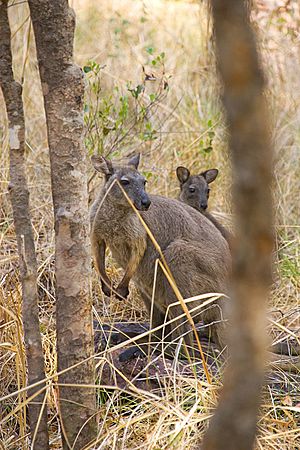Black wallaroo facts for kids
Quick facts for kids Black wallaroo |
|
|---|---|
 |
|
| Conservation status | |
| Scientific classification | |
 |
|
| Black wallaroo range | |
| Synonyms | |
|
The black wallaroo (Osphranter bernardus), also known as Woodward's wallaroo, is a type of macropod. This means it's part of the kangaroo and wallaby family. It lives in a small, rocky area in Arnhem Land, Northern Territory, Australia. This special area is between the South Alligator River and Nabarlek. Because it lives in such a small space, it's considered near threatened. A big part of its home is protected by Kakadu National Park.
Contents
About Its Name
The black wallaroo was first described by Walter Rothschild in 1904. He first gave it a different name, Dendrodorcopsis woodwardi. But later, experts decided it was actually a type of Macropus.
The name woodwardi was already used for another wallaroo, so Rothschild gave it a new name: bernardus. That's why its scientific name became Macropus bernardus.
In 2019, scientists looked at macropods again. They decided the black wallaroo should move to a different group called Osphranter. So now, its full scientific name is Osphranter bernardus.
People also call it by other names, like black kangaroo, northern black wallaroo, Bernard's kangaroo, and Bernard's wallaroo.
What It Looks Like
The black wallaroo is a smaller member of the kangaroo and wallaby family. It's also the smallest of all the wallaroos.
- Males are usually very dark brown to black. They might have yellowish fur on their forearms.
- Females are lighter, often greyish-brown. They have dark brown or black fur on their legs and tail tips.
This difference in color between males and females is called sexual dimorphism.
Black wallaroos have a round, muscular body and short, oval-shaped ears.
- Their head and body together can be up to 730 millimeters (about 2.4 feet) long.
- Their tail is usually 640 millimeters (about 2.1 feet) or shorter.
- When standing, they are about 800 millimeters (about 2.6 feet) tall.
- Males weigh between 19 to 22 kilograms (about 42 to 48 pounds).
- Females are lighter, usually around 13 kilograms (about 29 pounds).
One special way to tell a black wallaroo apart is by its teeth. It has a unique groove on its second front tooth.
How It Behaves
Black wallaroos are very shy animals. If they see someone, they will try to run away. They often hide in nearby hills or rocky areas called escarpments. They are very good at leaping onto ledges or climbing down rocks.
They also hide from the sun under rocks or in the shade of big trees. They only come out to find food like grasses and herbs, or to drink water.
Not much research has been done on black wallaroos. But we know they are nocturnal, meaning they are active at night. They are also grazers, eating plants. They don't usually live in big groups.
They find safety from predators and bad weather in the rocky cliffs or caves of their home. They quickly go to these shelters if they are disturbed. They stay hidden until night when they come out to look for food.
Black wallaroos are not very social. You usually see them alone, or sometimes a male and female pair with one young wallaroo. They might be seen with other types of wallaroos, like the antilopine kangaroo or the common wallaroo, especially when they gather to drink at waterholes.
Where It Lives
The black wallaroo lives only in a specific part of eastern Arnhemland. This area stretches from the South Alligator River to Nabarlek. You can find them in places like Mt Brockman and Nourlangie Rock.
Their home has a monsoonal climate, which means it has wet and dry seasons. They mostly live in woodlands, rainforests over sandstone, and sandy plains with different types of grasses. The soil in their habitat is very thin, with lots of bare sandstone rocks.
In Aboriginal Language and Culture
In the Kunwinjku language, which is spoken in West Arnhem Land, male black wallaroos have a special name: barrk. In the Kuninjku dialect, they are called nadjinem. Female black wallaroos are called djukerre. It's common in the Kunwinjku language for male and female kangaroos or wallabies to have different names.
People in Kunwinjku culture sometimes say that black wallaroos are the 'pets' of spirits called Nakidjkidj. They are also sometimes kept as pets by Kunwinjku people. Reverend Peterson Nganjmirra said they are 'quiet' animals.
See also
 In Spanish: Walaró negro para niños
In Spanish: Walaró negro para niños


